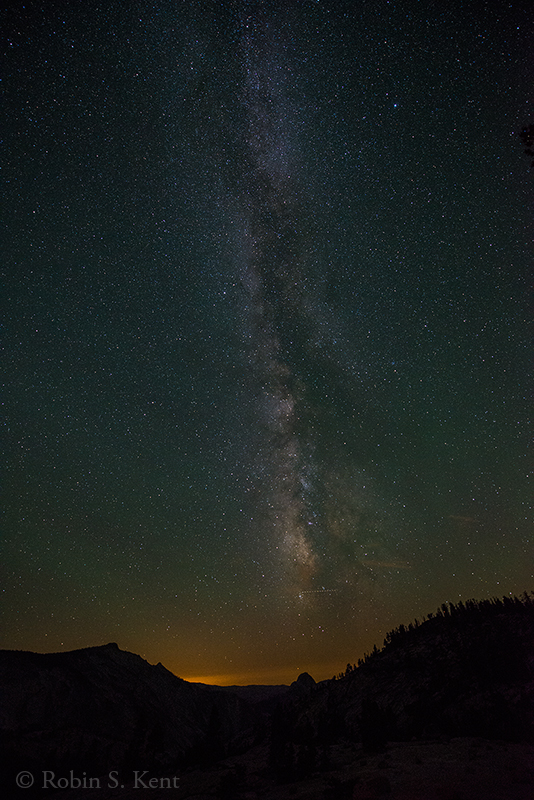The night sky, unsullied by the artificial lights of civilization, never ceases to amaze me. Even here in Yosemite National Park, you cannot find absolute darkness but you can get pretty close. Last night was the first night of our night photography workshop, led by Michael Frye, and Olmstead Point in the eastern portion of the park would be ground zero.
We arrived about an hour before sunset and hiked a short distance up an inclined granite dome littered with glacial erratics and a scattering of pine trees that somehow had found places to grow on this massive stone. This little jaunt took us only about 100 yards from the parking area, a spot that provides a premium viewpoint for little effort. This will not be the case two nights from now, however.
But I digress. If you are in a good location, capturing a single image of the Milky Way is relatively simple, except for one minor thing: focusing in the dark. It doesn’t work to simply turn the lens to the infinity point until it stops because modern lenses are designed to go a little past infinity. We were given several techniques to try (subject for a future post) and I opted for using the Live View function on my camera.
The Milky Way becomes visible to the naked eye about 2 hours after sunset and then moves slowly across the sky as the earth rotates. This gives one the opportunity to find several possible compositions using foreground objects and/or the horizon. The highlight here would come at about 11:00 PM when the Milky Way would be directly above Half Dome, seeming to erupt from this iconic feature of the park in a spectacular arc across the entire sky above us and disappearing into the horizon to our north.
In order to capture as much of the sky as possible, we all used very wide-angle lenses and in my case, that is a 14-24mm f/2.8 zoom. The image showing Half Dome is below. Because it is several miles away and the lens was set to 14mm, Half Dome is a little hard to pick out in this small size, but it is there (the small bump in the valley on the horizon) if you look carefully.
Milky Way over Half Dome
(Technical Data: Nikon D800E on tripod with 14-24 mm lens extended to 14mm; exposure: 15 sec. @ f/4.0, ISO 6400, Time of day: 11:17 PM)
The group then spent some time working on light painting, which involves using a flashlight or other light source to illuminate an object in the foreground while using the sky as a dramatic background. Michael knows Yosemite extremely well and he led us to a Western Juniper pine tree that he had found several years ago. The group clustered around the tree, each one selecting a different composition and on the count of three, shutters were opened and a member of Michael’s team “painted” the tree with a flashlight for about 2 seconds. The result is shown below.
Juniper Tree and Milky Way
(Technical Data: Nikon D800E on tripod with 14-24 mm lens extended to 14mm; exposure: 15 sec. @ f/4.0, ISO 6400, Time of day: 12:25 AM)
Tonight, depending on weather conditions, the group will be off to another location. Again, thanks to Latte Da Coffee in Lee Vining for making this post possible with their wi-fi service. And another good cup of coffee which I desperately needed.



Robin, These are beautiful shots.
LikeLike
Thanks very much. Hopefully, they will be a little better after I apply the techniques we are learning for processing night time photos.
LikeLike
What a gift getting to enjoy these incredible photos while you do all the work 🙂 I can’t imagine these images can be improved upon in post-processing, Robin. They are simply stunning!
As an aside, I found the light painting technique very interesting. In fact I just read about a night session being offered in DC doing exactly this. Now I have a grasp what’s involved. So creative! And the result is fantastic.
LikeLiked by 1 person
Thanks, Stacy. That’s very kind of you to say. Any changes will be fairly subtle, and will have to wait until I get back home where I have a better display monitor than my laptop. Haven’t heard about that DC session. I’ll have to check that out; it’s a little closer to home;-)
LikeLike
Hi Robin, your photos are amazing, and inspiring! I was surprised to read that you could not find absolute darkness in Yosemite.
LikeLike
Thanks very much for the comments. True, it’s pretty dark in Yosemite once you get away from the valley where the lodging/restaurants, etc are located. You have to hike a mile or so to get away from auto lights traveling on the park roads but even then distant cities will cast a fairly bright glow even if they are 100 miles away. But there is an upside to that in that they define the horizon in a photograph.
LikeLike